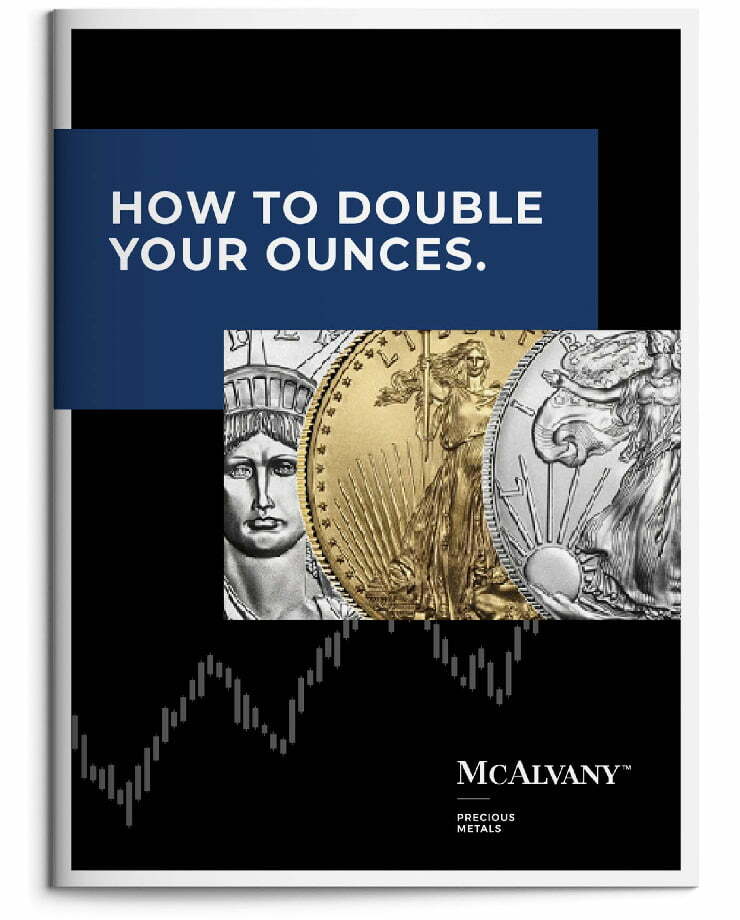Podcast: Play in new window
- Did Anyone In Government Read The Big Beautiful Bill?
- “Genius Act”: A Crypto Version Of Fiat Dollar
- Tomahawk 6 By Broadcom Threatens NVIDIA Share Value
“The gold market has been driven by central bank demand, and one of the reasons why I wanted to highlight some of the moves in silver today and the change in the ratio in silver is because the general public is entering the market, and this is our confirmation. We’ve been looking for this for months. Yes, as the gold-silver ratio shrinks, as silver begins to outperform and break out above the 34, $35 an ounce level, this is the next leg of a significant bull market in metals.” —David McAlvany
* * *
Kevin: Welcome to the McAlvany Weekly Commentary. I’m Kevin Orrick, along with David McAlvany.
David, it was such an honor to be at your father’s surprise party on Friday night, and we had great food, thanks to you guys, but when it was time to roast Don, your dad is such a fun guy because he’s very loyal, loves the people around him, really respects them. So, the roast as we went on, these are guys who’ve known him, really almost all of our adult lives. As we started to roast, we realized it’s not a roast at all. The things we said about your dad and the impact that he had made in our lives, he wept. He realized that there was such a deep reality. Let’s just put it this way, he started a business in gold and silver, but the quality and the integrity of his life really does, it represents gold and silver. It’s pure gold and silver.
David: To his chagrin, I was sharing with him that when he enters a room, my blood pressure goes up, and he thought, man, this is really tough to hear that I have such a negative impact on my son. And I thought, no, actually this is who he is. There is a bit of an uncomfortability. He sees things with clarity and says them with clarity. And sometimes being willing or able to speak the truth brings in uncomfortability with it, not intentionally, it’s just who he is when he’s operating in his strengths, and he often is, that’s an impact that he has. There’s an aha moment and sometimes the aha is relating to the national debt or relating to public policy or relating to something that he’s just speaking off the cuff, but which gets to the heart of the matter. And it’s been a remarkable gift. It’s been a blessing to us as a family to have that as a part of our family for decades and decades. So, 85 years old, 85 years young, frankly.
Kevin: Yeah. That’s true. No, he’s that type of personality when he walks into the room, there’s a required response. You believe that he has a mission that’s larger than what we’ve been looking at, and he always has carried things on like that. You guys went on over to Branson, Missouri. It’s going to be a larger reunion. I think you’ve got quite a bit of family coming in.
David: That’s right. We’re in Branson for the McAlvany-Bowers family reunion. My parents like us to get together every other year, and this year we’re overlooking Table Rock Lake, a stone’s throw away from Silver Dollar City and the wild roller coasters of the 1880s theme park.
On that note, I can’t help myself, silver in the 1880s was a common expression of sound money. The term sound money referred to the sound which a gold or silver coin made, a clear ringing sound when struck against another piece of metal. It was a sign of integrity, a solid ringing told the holder that the currency had not been debased by anything else. So, take a 100-ounce silver bar today, hit it with another piece of metal, like a 16 penny nail, and it sings.
If the bar has been drilled and filled with lead, you get a thud and not a ring. It’s simple, but true. Debasement was something anyone could recognize then, and it’s not so easy today in an age of paper or fiat currency. We think inflation is normal. The inflation target of 2%, popularized by the central bank of New Zealand in the 1990s, maybe we’re running a little hotter than 2% now. But that range, it’s below the threshold of pain perceptible by the public. So much so that today we don’t even stoop to pick up a penny. Why would we care about a low rate of inflation in that sort of two-penny range?
Kevin: It’s interesting when you talk about a 100-ounce bar of silver singing if it’s hit with another piece of metal. As you know, I play trumpet, and I’ve got a silver plated trumpet because it makes it sound better and then my mouthpiece is gold plated. And it has to do with the sound, it has to do with the comfort, but you brought up the penny thing, and I noticed something about me the other day, and it shocked me a little bit. There was a penny down on the ground and I walked past it. This was probably the first time ever that I did that. And I’m wondering, at what point in a civilization does money that you used to value, you no longer value it? I’m wondering if there’s a meter. Like the Weimar Republic back in the early 1920s, there was a point where it wasn’t worth picking up the currency.
David: A penny is in that range now. Sometimes a nickel, I’ll stoop for that. A dime and a quarter definitely still catch my attention. But cumulative low levels of debasement are a policy tool of the modern central bank community, and the excuse is to drive economic growth. If we catch 2% inflation, we’re hoping for far more than that in terms of economic growth. The effects of debasement are not dramatic in the short term, but they are highly consequential over time. And again, back to the 1880s, a $1 silver coin in 1880 is over $30 today.
Kevin: You were talking about Silver Dollar City having the old 1880s roller coasters, but I wonder what wages would’ve looked like back then relative to now.
David: Yeah. $1.50 was the daily worker’s wage in the 1880s. A little less for a factory worker. If you had some skills, the stenographer was paid five bucks a day; an attorney made $8 a day; and if you’re up-scaling, if you were the attorney general, $25 a day. Supreme Court Justice, $33 a day. Just to show you that we’ve always undervalued education, a teacher was a little less than $4 a day. White women made less than half that amount, and women of color made less than half of white women. Of course, that was the 1880s, long before universal suffrage. Those numbers come from the register of the Department of Justice in 1885 and the report of the Commissioner of Education, and of course, I adjusted the teacher’s salary to a five-day work week. Everyone else was still working six at that point.
Kevin: Well, there have been a series of devaluations while we were still on the gold standard. Obviously, we’re just in free-floating fiat at this point, but that standard of living was hard to maintain even when we were on a gold standard because they kept devaluing the currency relative to gold.
David: Yeah. Some things have changed since the 1880s. Some things have stayed the same. Whatever your income level, your purchasing power has remained under pressure, with most of the diminishment taking place after leaving the gold and silver money system. We did that incrementally following the conference of Genoa in 1922, 1933, the key devaluation when we made gold illegal to own by US citizens, 1944, Bretton Woods, 1971. Those are sort of the progressive periods of debasement for the currency. Those are the years to remember when recollecting the stages of debasement. So, maybe 2025 will be added to the list. Time will tell.
Kevin: Yeah. Do you remember when a person said, “Gosh, I just want to be a millionaire.” These days you can barely retire on a million dollars. And nominally, it looks like people are making more and more. There’s more millionaires now than ever, but are they really keeping up with the cost of living the way they would’ve lived 100, 150 years ago?
David: Well, this is where something as basic as gold and silver, they tell the true story. In nominal terms, it looks like we’ve made huge improvements. Supreme Court justice making $317,000 a year at present, a lot better than 10,000 a year back then, 48 times better when you consider the five-day work week in the current environment versus six days back in the 1880s. Yet, the real story is a little different. Gold has increased 150 times, silver, 35 times at today’s gold-silver ratio, 91 to one. And of course, we still had the statutory rate of 15 to one, which is what it was. That was established by the Coinage Act of 1792. Silver would be over 200 times the old value. So in real inflation-adjusted terms, everyone from the Supreme Court justice to the factory worker is making less, not more. And again, this is the deception, if you will, of fiat or paper money. Inflation as a policy tool is subtly deceptive.
Kevin: Let me ask you, the 15 to one ratio. Oftentimes we talk to our clients about ratios relative to gold and silver. Was 15 to one ever realistic, or did that always have to be held by mandate?
David: Yeah, there’s different ratios if you look back through time, Kevin. We had during the middle-ages between nine and 12 to one. The in-ground ratio, if you’re looking at geology, it’s about 16 to one. 15 to one was what was established by the Coinage Act. 15 to one is not a realistic number outside of a mandated currency exchange rate, but 50 to one certainly is. And silver in the last week or so, moving over $35 an ounce. It’s in breakout mode. It won’t take long to retest the 2011 nominal highs. Silver is following on the heels of gold in a secular bull market, and the ratio is telling you that something is changing.
Kevin: Yeah. What an interesting year this has been to see silver over 100 ounces to one. The 38 years that I’ve worked here, I’ve never seen anything quite like it. So it’s about time. It’s almost like there’s a delayed action. Gold made its rise and is making its rise based on central bank buying—not public buying, but central bank buying. And it’s sort of left silver in the back room for a little while. But at this point, you’re saying we’re in breakout mode.
David: Yeah, the ratio has been too high for all of 2025, and we’ve argued that a shift in the ratio to lower numbers would serve as a confirmation of the metals bull market. And critically a sign of the Western investor stepping back into the metals market. So the ratio’s moved from 101 to 91 in 10 days. The ratio is starting to signal something.
Again, the April high was 107. So we’re coming off of those highs. And just for historical reference, 600 months, if you’re looking over a 40- or 50-year period, only 1.8% of the time has silver been over 101. So this is the rarefied air. Leaving it, we’re moving into the more common space of much lower numbers, which is to say silver moving into outperformance mode relative to gold.
Kevin: And we’re seeing, not just in silver. We’re starting to see platinum and copper. So is this the industrial side of silver that we’re watching as well?
David: Yep. This is where things are certainly tricky as we consider the tariffs and whatnot, but silver is doing what it often does, play rapid catch-up to a move in gold. That it is supported by the industrial commodities—other industrial commodities—is very intriguing—platinum, copper.
We remain unclear what the Trump tariffs will translate to in terms of global GDP growth. Last week’s report from the OECD, they’re in the process of reducing their 2025 GDP growth expectations globally. Ultimately, what will the demand be for industrial commodities? That remains to be seen, but price action is telling us something. In this cycle our best guess is that the gold-silver ratio contracts to between 65 and 75, which implies a 44 to $51 price range. Of course, we’re assuming a more or less stable gold price, but those price levels, that’s the retest of the 2011 highs.
Kevin: I know you like to look at something relative to something real. So in other words, acres of land relative to gold or ounces of silver relative to gold. But if you look at the nominal value, you were just talking about a Supreme Court justice makes over $300,000 a year, yet he’s not making as much as he was when he was just making much, much less than that because of the nominal value. So how much are both metals up this year? We’ve had a really good year so far in the metals.
David: Right, over 25% year to date. And the companies that mine them, twice that, year to date. Of course, there’s some differentiated performance depending on the quality of assets and management and jurisdiction and things like that.
The Morgan silver dollar and the $20 gold piece, those were the coins of the realm. The US dollar, as often been said, is our currency and it is the world’s problem. But from a historical perspective, again, coming back to the nominal versus relative values, it’s our problem as well.
So the teacher in 1880, if you calculate, the annual pay is roughly 40 ounces of gold a year, and the Supreme Court Justice 500 ounces a year. If they were paid in gold today, again translated to current dollars, the teacher would make 133,000. The Chief Justice would make close to $1.7 million. So time and inflation are problematic. Again, we like to say the US dollar is our currency, but it’s the world’s problem. But it’s very much our problem as well. The teacher is making 30 to 50% of what they did in 1880. The Supreme Court Justice is making just 19% of what they were paid under the gold standard. Nominal values are in that sense deceiving.
Kevin: So what do you say to the person who says, “Yes, but we’re moving to a new currency system.” A digital currency system, what they call a stable currency. That’s the name they’re using.
David: Yeah. Well, the irony is in the name. The irony is in talking about adopting and expanding the use of a digital version of the dollar, and they like to call them stable coins. The irony in their value is tied to the mighty buck. So what is the value of a stable coin? It’s worth a dollar. And as we’ve seen, it’s inherently unstable over time. So to call it a stable coin is a bit of a joke. A digital iteration doesn’t change the fact that the underlying instrument has an integrity issue. It is inherently unsound.
Kevin: One of the things that people who are really pushing the digital currency side of things do is they say, “Hey, you guys are just behind the curve. You need to catch up with us. We’re the geniuses here.” And isn’t it interesting that the Genius Act— Literally, they call it the Genius Act when it comes to this digital currency.
David: Right, anytime legislation is named something that is that provocative, the Patriot Act, you’ve got to be for it or you’re not a patriot. The Genius Act, you’ve got to be for it or you’re an idiot, right? There’s like an implicit get on board, this is where we’re going. So on deck, the also ironic Genius Act, which stands for guiding and establishing national innovation for US stable coins, and if it’s passed—
Kevin: Genius.
David: Yes, right. It’s argued that it will bring the US dollar and the Treasury market into the 21st century. You can count me skeptical. For those that have spent a minute studying postmodernism, this is the monetary expression of postmodernism at its finest, a new dollar to do the work of the old dollar, the cryptographical reflection of a fiat dollar. Something that doesn’t have any intrinsic value, and now we’ve got some sort of cryptographic version of it. Need a labyrinth of mirrors for excitement and intrigue? Stable coins provide it. Genius? We’ll see about that.
Kevin: Maybe call me an idiot, but I’ll take that Morgan silver dollar any day from a digital version of a stable coin connected to a fiat dollar.
David: I’d prefer to be paid in $20 gold pieces frankly. You can keep your silver. I like the gold. No, arguably silver is intriguing with the ratio moving into outperformance mode.
Stable coins will in theory hold the value of a dollar. It’s the dollar—the question of what the dollar’s value will be—which is the bigger issue. So whether the dollar will hold its own is the separate and debatable issue. So a new currency, new payment systems, I wouldn’t hold your breath, but the Trump administration—or really we should say the Trump family—is eager to make a buck, even as they may add to the breaking of the buck.
And that’s the final irony. There’s some challenges to the whole notion of cryptocurrencies, which are just related to technology, and this is something that we’ve harped on for years. Change is the constant with technology. One innovation is cannibalized by the next, and as things change in the world of cryptography, I think you’ll find that there’s not much value left in the world of crypto.
Kevin: Dave, the whole idea of cryptography, which is what is the basis of all these cryptocurrencies, is a fascinating thing because for thousands of years there’s been a reason for mankind to keep secrets from each other, whether they’re military or monetary. And yet every single form of cryptography—every single form—has ultimately become something that could be broken. And the cryptocurrency, no matter what people say, this time is not different. And quantum computing is intriguing. When you talked about technology, quantum computing is one of those types of technologies that could change everything.
David: Yeah. And to be clear, I’m not conceding that by adding the term crypto to any currency, that it is really an innovation, at least innovative in the direction of soundness. If you do take that step, you still have that killer technology looming out there in the form of quantum computing. Unique cryptography is required to maintain the security of stable coins. ECDSA or Elliptic Curve Digital Signature Algorithm cryptography—which, you might’ve guessed, has a kryptonite, and that’s quantum computing.
So the distributed digital ledger is a beautiful thing unless or until it’s breakable. So, remains to be seen who will be the provider of the kryptonite. Google, IBM, DARPA, or someone else shatter the digital image of monetary perfection? By the time stablecoins are adopted, which it appears this administration is very keen to do, there’s going to be an undoing of the post-fiat dream, the post-modern version of money. Google warned just last week that quantum computers could crack Bitcoin encryption 20 times faster than expected.
So what is the value of bitcoin in a world where mining it takes a fraction of the effort and a fraction of the time, how does quantum computation change the functioning of the distributed ledger? There is comeuppance day, the Q-Day, which is fast approaching.
Kevin: Yeah, I’ve got a number of books on cryptography—just because that’s been of interest—through World War II, some of the major breaks in code. I would recommend the listener, if you want, a book that was written I think about 20 years ago by Simon Singh is called The Code Book. It doesn’t get too much into the quantum computing, but it does show you the pattern of how humans have been able to create secrets and then break secrets. And that really is something that we’re moving into at this point. But this could be devastating for technology that we think is going to be around forever.
David: Evan Lorenz at Grant’s Interest Rate Observer allows us to imagine how technology will be again, as it always has been, disruptive. Disruptors are disrupted. That’s sort of the history of technology and change. I think the earlier comment on stablecoins fits this bill, except he’s illustrating this with Nvidia. So yes, DeepSeek was a shot across the bow for euphoric investors aboard the Carnival Cruise ship captained by Jensen Huang. Nvidia is the provider of GPUs, those chips that are powering the data centers that make AI what it is, what it has been. DeepSeek showed how more computations could be done with less equipment if you followed the 80/20 rule. Design your software to be more efficient, and you can reduce the need for so much hardware, and that’s a problem for Nvidia.
Lorenz points to a potentially bigger problem, and I remember well the increased demand for fiber optic capacity in the 1990s. Lorenz recalls that the internet data doubled every hundred days in the 1990s. He says to meet that exponential growth, telecom firms laid down thousands of miles of fiber optic cables, and his chronicle includes, “1995, cutting edge ethernet speeds clocked in at 100 megabits per second worth of data. By 2002, advancements in dense wavelength multiplexing, which enables one fiber optic cable to carry many signals simultaneously, allowed telecoms to offer ethernet speeds of 10 gigabits per second, a hundred-fold jump in capacity.”
For those of you who don’t know the players of the day, WorldCom controlled over 90% of the internet backbone via its network of cables, and they couldn’t keep up with demand. So they just kept on laying down more cable, until technology leapfrogged them and demand couldn’t keep up with supply. That’s the issue. So as it relates to Nvidia, Broadcom last week introduced the Tomahawk 6, it’s funny that it sounds like it’s named after a guided—
Kevin: A missile. Yeah, right.
David: Broadcom introduces the Tomahawk 6, with six times the throughput capacity of its earlier offerings. And so to the users of AI, this means that utilization rates of their GPUs will increase considerably. The rough translation is, how many GPUs do you really need if you get more out of what you already have? Again, it’s very similar to WorldCom’s issue back in the late ’90s and early 2000s. How much fiber optic capacity do you need when you’re getting more efficient use out of the cables that have already been laid?
The Broadcom announcement came on Tuesday. On Monday, Mark Stevens, previously with Sequoia Capital and an Nvidia board member for many, many years, on Monday, he sold $550 million worth of Nvidia. Well that’s interesting. I’m sure he had no idea that Broadcom was bringing the Tomahawk 6 to market.
Kevin: It makes me think of the old long-play albums, Dave. Let’s say you put a lot of your investment into record players that just played LPs. Granted, there’s sort of a nostalgic return, some people are going and buying a few of those. But everything changed when things went digital. And I’m wondering if that’s not what we’re seeing right now, where this disruption, you can’t necessarily see how it’s going to come, but you know it does.
David: I remember the WorldCom overcapacity leading to unused dark fiber very well. My wife’s family had an exclusive contract to provide fiber to Southwestern Bell, and they had to carry the inventory and provide it just in time. So go back to 2001, WorldCom imploded, as did demand for fiber optic cable. Overcapacity is a macro concern, and for this family owned business unsellable inventory is a micro consideration. But extinction events are real, whether they’re at the macro or micro level, and I recommend avoiding them if you can.
So back to Lorenz, he says that Nvidia is making faster GPUs. Broadcom is making chipsets that enable those GPUs to have higher run times, and new AI models like DeepSeek are requiring fewer GPUs to shine. There’s an important point in Grant’s piece, Kevin. It’s the bottom line, if you will, revolutions eat their own.
Kevin: Speaking of eating your own, okay, we’re talking about technological revolutions. A lot of people would think that the Trump administration is a revolution, but speaking of eating your own, we need to talk politics just a little bit here, Dave.
David: Well, clearly the drama of last week was between two of the most powerful figures in the world, between Musk, the most moneyed man of all time, the wealthiest individual on the planet, and perhaps the most powerful man in the world, Donald Trump. As I mentioned, we are here in Missouri with family. My brother-in-law was in the state legislature in Idaho years ago. He spent every waking hour reading proposed legislation. His colleagues were puzzled by that. None of them read what they voted on, and he was the exception to the rule. Too many pages, too many bills, not enough hours in the day. And I remember at the time him telling me that it was burning the candle at both ends to get everything read to be ready for a vote.
By the way, the volumes at the state level are a fraction of what is pushed through in DC. So what are they forced to do? Read the summary that staffers put together. That has to suffice, and yet the devil’s in the details.
Kevin: Okay. This detailed devil that you’re talking about, granted, you’ve got these two powerful men who are at odds with each other. Do you think most, or any, of the people in Washington have read the Big Beautiful Bill?
David: And I think this is where we find a key difference between the two. One is leaning on principle, the other on sheer pragmatism. In the Big Beautiful Bill, I think the devil is in the thousand pages. No one read it. No one read it. How can the House or the Senate be thought of as representing the voice of the people when they’re voting blind on proposed legislation?
We, the people, are subject to the laws of the land once they’re passed, yet not even our legislators know what they’re creating as the law of the land. And Mike Johnson was very vocal. He told us, “I’ll tell you what, do not doubt, don’t second-guess, and do not challenge the President of the United States, Donald Trump. He is the leader of the party. He’s the most consequential figure of our time.”
As I thought about that quote, there was one question: Mike, did you read the bill? And in fact, he might’ve been the only one that did. You have a usual 72-hour allowance, once the bills are published, to be read before they’re voted on. The usual 72-hour allowance was circumvented by the speaker’s use of what’s called a manager’s amendment.
No one knew what was in the bill prior to voting on it. And this is coming back to unsound money. This is what I would consider to be unsound legislation. It’s as bad as unsound money because you have far-reaching implications borne by future generations because of a present-tense expedience.
What is the job description of the Senate and the House? Does it not include knowing the details of what you’re putting into law? And if so, I think we could rightly look at their job description and say they haven’t done their jobs. Don’t doubt? Don’t second-guess? These kinds of insinuations of just go along to get along, I’m liking the idea of a third party.
So in the 1880s, a senator was paid $5,000 a year, and they might’ve been worth it. At $174,000 a year today, I don’t think they’re worth a fraction of that. There are 6,771 bills and resolutions currently before Congress. How many pages? I have no idea.
Kevin: Dave, we’ve got several guests coming on over the next month, and the culmination of the pages of the books that we need to read—or I need to read—before we interview them is a little over a thousand pages, and it’s going to take me— That’s 72 hours that they give the legislators? Even if they didn’t have that mandate. What was it called? The manager’s amendment?
David: Yep.
Kevin: Even if that wasn’t the case. It’s going to take an awful lot of time to read these books. Now, they’re interesting. I can’t imagine a bill being interesting. But the sad thing is, when you talked about a third party, if the two parties that we have now don’t read the bills that they pass, we better have one. I’d like your brother-in-law to be part of that.
David: Well, the sanctions that we are putting against a number of countries and considering re-upping the tariffs which are in place—maybe they’re out of place—10 different times between now and the end of the month. The on and off is a constant thing now.
We want to look at more of the details there, and the implications of the financial choke points which the Trump administration is exercising both through the State Department and the Treasury. And we’ll have a couple of guests on to look at both sanctions policy as well as sort of strategic choke points.
We used to think of choke points as geographic in nature, whether it was the Straits of Malacca or the Suez Canal. These are more financial choke points, and they tie directly into our sanctions regimes. This is the way in which we are exercising our power in the world today.
And it’s one of the reasons why global central banks are looking for greater distance from the dollar, greater distance from the Treasury market, greater autonomy from the controls that we’re trying to put upon them. And it is one of the things that has driven the gold market to date.
We’ve talked about this ad nauseam—that the gold market has been driven by central bank demand—and one of the reasons why I wanted to highlight some of the moves in silver today and the change in the ratio in silver is because the general public is entering the market.
And this is our confirmation. We’ve been looking for this for months. Yes, as the gold-silver ratio shrinks, as silver begins to outperform and break out above the 34, 35 dollar-an-ounce level, this is the next leg of a significant bull market in metals.
* * *
You’ve been listening to the McAlvany Weekly Commentary. I’m Kevin Orrick, along with David McAlvany. You can find [email protected] and you can call us at 800-525-9556.
This has been the McAlvany Weekly Commentary. The views expressed should not be considered to be a solicitation or a recommendation for your investment portfolio. You should consult a professional financial advisor to assess your suitability for risk and investment. Join us again next week for a new edition of the McAlvany Weekly Commentary.
















